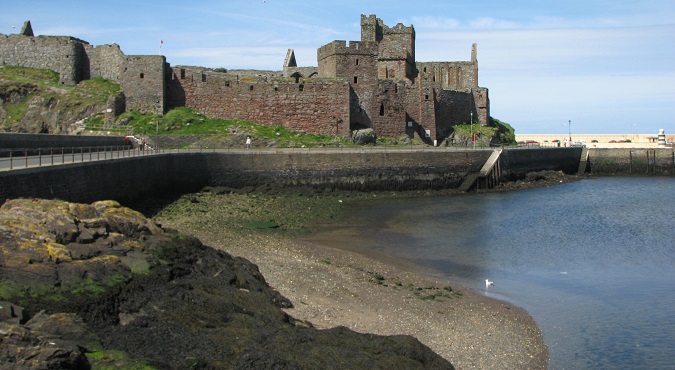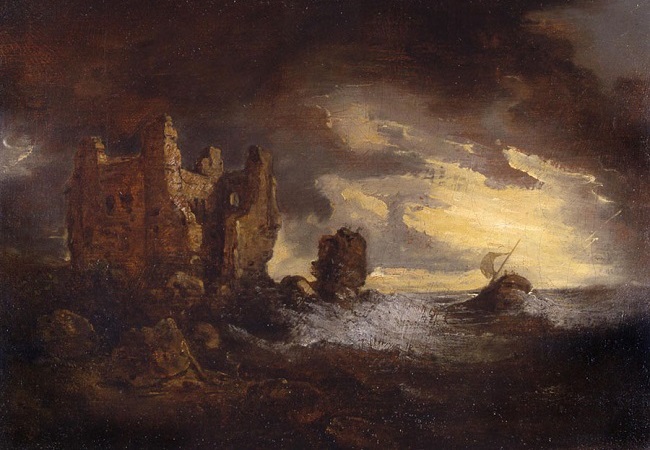
The poem “Elegiac Stanzas” by William Wordsworth is, as its name implies, a melancholic poem. The speaker of the poem, presumably Wordsworth himself, depicts his own mental transformation in which he grows from a naively happy state of mind during his younger years into a gloomily matured person who perceives the world in a much sadder sense.
To convey his pessimistic mind shift, Wordsworth uses similar imagery of an actual place in nature, described in three ways: Wordsworth’s remembrance of Peele Castle as he recalls it, a real painting of this locale by George Beaumont, and a portrayal of a painting Wordsworth would have painted if he were to paint Peele Castle. This essay will discuss Wordsworth’s morose transformation through those three renderings of the scene.
Immediately at the beginning of the poem, it is clear that Wordsworth is intimately acquainted with the Peele Castle scenery and holds ambivalent feelings toward it. In the first stanza, he addresses the castle itself and recounts that he spent “[f]our summer weeks” there, during which he “saw [it] every day” (2-3). Wordsworth also expresses in this stanza his inner conflict; he negatively refers to Peele Castle as a “rugged Pile” (1), and just a few lines after, he positively indicates that its “[f]orm was sleeping on a glassy sea” (4). This stanza constitutes a sort of exposition that divulges Wordsworth’s emotional struggle and dour transformation.
In the second and third stanzas, Wordsworth describes his recollection of Peele Castle out of his memory when he was there for a month. In his past perception of the place, Wordsworth idealizes it; his recollection of it is of a heaven-like harbor to which no troubles nor worries can infiltrate. The repetition of the word “so” four times (5-6) conveys the sense that Wordsworth romanticizes Peele Castle and envisions it as a fanciful serene utopia that can only exist in the imagination.
The image that the third stanza evokes is of a completely peaceful landscape wherein “perfect [is] the calm” (9) and as surroundings that even the turbulent sea is “the gentlest of all gentle Things” (12). This kind of portrayal of a dreamlike scenery is clearly imaginary, and as later he will show, Wordsworth is not unaware that he merely conceptualizes it in his mind as such a fantasy.
Wordsworth’s train of thought wanders from there into contemplation of how he would have painted Peele Castle if he had “the Painter’s hand” (13), referring to a real painting by George Beaumont, as the title indicates. Wordsworth admits that he would have supplemented his hypothetical painting with additional elements to enhance the beauty of its natural appearance; he would have added, “the gleam, / The light that never was, on sea or land, / The consecration, and the Poet’s dream” (14-16). The embellishment of the hypothetical painting to enrich it artificially parallels Wordsworth’s glamorized perception of the real Peele Castle from the prior stanzas. Thus, Wordsworth brilliantly implies that not everything in one’s recollection is entirely accurate, just as not any painting is an exact representation of reality.

Wordsworth’s past antagonism toward George Beaumont’s painting is evident when he declares that he would have painted Peele Castle “[a]mid a world how different from this” (18). Unlike Beaumont’s painting, Wordsworth describes his own imagined painting as a scenery of nature full of happiness and calmness, with words such as “tranquil,” “bliss,” “divine,” “peaceful,” “heaven,” “ease,” “Elysian” and “silent” (19-28).
In comparison, Beaumont’s painting of Peele Castle is entirely different from Wordsworth’s peaceful portrayal of his hypothetical painting. Beaumont’s painting is painted mainly with dark colors, which convey an ominous feeling; both the sky and the sea are stormy and tumultuous; the small boat on the right side is carried on a portentous wave; and Peele Castle itself is portrayed in a Gothically eerie manner. It would be impossible to ascribe any of Wordsworth’s painting descriptions to it. This acute contradiction between the two artists emphasizes how the exact same settings of an actual place can be affixed so dissimilarly, and even completely oppositely, in the minds of different people.
However, at the time Wordsworth writes this poem, he admits that he was already transformed and that now he would not have painted Peele Castle so differently than how Beaumont would. He confesses about his youthful perception of Peele Castle that “[s]o once it would have been,—’tis so no more” (33), and he even discloses grimly, “[a] deep distress hath humanised my Soul” (36).
The poem does not exactly specify what had happened that transformed Wordsworth into such a dark view of nature and life, but in his book, Deep Distresses, Richard E. Matlak sheds some light on Wordsworth’s “renunciation of his gladsome belief in Nature’s benignity” (Matlak: 2003, p.17). Matlak writes that Wordsworth had a brother called John, who found his death at sea as a mariner; therefore, “[John’s] death prompted William’s dramatic renunciation of his youthful romanticism” (Matlak: 2003, p.17) in poems such as “Elegiac Stanzas.” Indeed, a tragic loss of a brother would elucidate why Wordsworth inconsolably laments in the poem that “[a] power is gone, which nothing can restore” (35) and that “[t]he feeling of [his] loss will ne’er be old” (39). Wordsworth acknowledges his full transformation as he professes that he could not “behold / A smiling sea” (37-38) anymore and even affirms the seriousness of his gloomy statements by adding that he “speak[s] with mind serene” (40).
Although the younger Wordsworth negated Beaumont’s painting, the current one embraces it. With an apostrophe directed at Beaumont himself, Wordsworth compliments his work while invalidating his own prior conception of the painting. Wordsworth actually relates to Beaumont’s Peele Castle so much that he feels personally close to Beaumont and calls him twice “Friend” (41). He fully endorses Beaumont’s version of the place and renounces his own prior vision of it, professing that “[t]his work of [Beaumont] I blame not, but commend” (43). While before, Wordsworth ascribes to the sea qualities of beauty and tranquility, now he confirms it is “in anger” (44) as Beaumont displays it; thus, after the sea “took” his brother, Wordsworth personifies it with temperamental attributes.
In contrast to the peaceful words Wordsworth describes nature in his hypothetical painting in the past, now he approves of Beaumont’s painting with words like “deadly,” “rueful,” “fear,” “unfeeling,” “fierce” and “trampling” (45-52). His revised choice of words underlines his new sadder attitude not just toward Peele Castle and nature but also, and perhaps primarily, towards life itself.
The last two stanzas of the poem complete Wordsworth’s 180-degree transformation and serve as a valediction of his former naïve self while also accepting his new somber attitude. He repeats the word “farewell” twice, departing from his younger “heart that lives alone” (53), which stresses the finality of his dreariness. He holds a bitter sentiment toward the juvenile “happiness” he felt before, which he now claims should “be pitied” because it is “surely blind” (55-56), insinuating that his current bleak feeling is the truer one.
The last stanza divulges Wordsworth’s acceptance of his transformation and his acknowledgment that from now on, he will perceive the world in darker colors, as in Beaumont’s Peele Castle. He “welcome[s] fortitude, and patient cheer” (57), adding that he would have to endure “frequent sights of what is to be borne” (58); those could presumably be similar sights of nature, such as Peele Castle, which he previously enjoyed but cannot anymore. Wordsworth recognizes that he now has to live with his grim transformation as he concludes in the poem’s last line, “[n]ot without hope we suffer and we mourn” (60).
“Elegiac Stanzas” strikes as a deeply intimate poem of Wordsworth, in which he recounts how he undergoes an elegiac mental transformation throughout the stanzas. He employs a similar image of nature in different ways in order to evince his various states of mind while also interlacing other brilliant observations about the mind and perception. There is no suggestion of how this transformation would affect him as a poet, but the poem itself remains evidence of Wordsworth’s ingenious ability as a poet, even in his darker times.
Matlak, Richard E. 2003. Deep Distresses: William Wordsworth, John Wordsworth, Sir George Beaumont, 1800-1808. University of Delaware Press.



